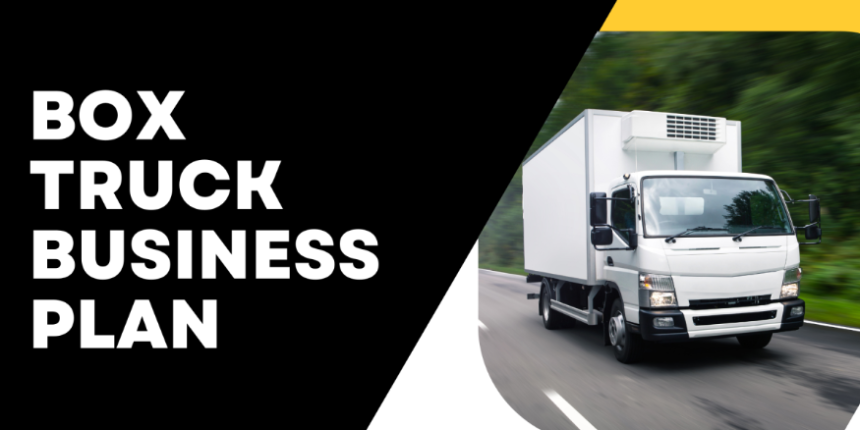A business plan for box truck service is a crucial document that outlines your business goals, strategies, and financial projections. It serves as a roadmap for success, helping you to secure funding, guide your operations, and stay competitive.
Why You Need a Business Plan for Box Truck Service?
If you’re starting or expanding a box truck business, a business plan is essential. It helps you to:
- Raise funding: Investors and lenders require a business plan to assess the viability of your business.
- Plan for growth: A business plan helps you map out the future of your company and improve your chances of success.
- Stay organized: It provides a framework for making informed decisions and managing your business effectively.
- Understand your market: Market research within the plan helps you identify your target customers and competition.
Key Elements of Business Plan for Box Truck Service
A comprehensive business plan for a box truck service should include the following sections:
- Executive Summary: This is a brief overview of your entire business plan, highlighting key points such as your mission, goals, and financial projections. SwiftTrans Logistics, for example, focuses on reliable transportation solutions, aiming to generate $500,000 in revenue in its first year.
- Company Overview: Provide a detailed description of your company, including its legal structure, mission, and values. If you choose a name like “SwiftTrans Logistics,” make sure it reflects your commitment to efficient service and is easy to find online.
- Industry Analysis: Research and present information about the box truck industry, including its size, trends, and growth potential.
- Customer Analysis: Identify your target market, such as e-commerce companies or local retailers, and their specific needs. Educational content can attract those who are researching ways to improve their business.
- Competitive Analysis: Analyze your competitors, identifying their strengths and weaknesses, and outlining your competitive advantages. Consider what sets you apart—better pricing, faster delivery, superior customer service, or specialized services.
- Marketing Plan: Describe how you will market your services to attract and retain customers. A marketing plan should detail your product, price, place, and promotion strategies.
- Product: Clearly define the types of box truck services you offer, such as GPS tracking or 24/7 availability.
- Price: Document your pricing strategy and how it compares to competitors.
- Place: Describe your base of operations, including facilities for vehicle maintenance and parking.
- Promotion: Outline your plans for advertising, direct sales, trade shows, your website, and online marketing.
- Operations Plan: Detail the practical aspects of running your business efficiently. The operations plan should cover key areas, such as fleet overview, location and premises, equipment and technology, staffing, and safety protocols.
- Fleet overview: Describe the types of box trucks in your fleet and their specifications.
- Location and premises: Detail the location of your base of operations, including facilities for vehicle maintenance, parking, and administrative tasks.
- Equipment and technology: Discuss the technology and tracking systems you’ll use.
- Staffing: Outline the roles and responsibilities of your team members, including drivers and administrative staff.
- Safety protocols: Address safety measures for both drivers and vehicles.
- Organization and Management: Describe the structure of your organization and the roles of key personnel.
- Financial Plan: Include financial projections, such as income statements, cash flow statements, and balance sheets. Also include important assumptions and a break-even analysis.
Steps to Create Your Business Plan
- Research and Gather Data: Collect information about your industry, target market, and competitors.
- Define Your Objectives: Set clear, measurable, achievable, relevant, and time-bound (SMART) goals for your business. Short-term goals should cover the next 1-3 years, while long-term goals should look 3-5 years ahead.
- Develop Your Strategies: Outline the specific actions you will take to achieve your objectives.
- Write Your Plan: Use a clear, concise, and professional writing style. Organize content under headings and subheadings. Use bullet points for step-by-step instructions and bold text to highlight important sections.
- Review and Revise: Proofread your plan carefully and seek feedback from trusted sources. Update your plan annually to reflect changes in your business and the market.
Optimizing Your Content for SEO
To enhance your online visibility, follow these SEO writing tips:
- Keyword Research: Identify relevant keywords and phrases that your target audience is searching for.
- Keyword Placement: Incorporate your keywords naturally throughout your content, including in the title, headings, and body.
- SEO-Friendly Format: Structure your content with headings and subheadings to improve readability and help search engine crawlers understand your content.
- High-Quality Content: Create useful, informative, and engaging content that provides value to your readers. Include step-by-step processes and real-life examples to make your content actionable.
- Internal and External Links: Link to other relevant pages on your website and to authoritative external sources.
SwiftTrans Logistics: A Sample Business Plan
To illustrate the key components of a box truck business plan, consider SwiftTrans Logistics. This hypothetical company aims to offer efficient and reliable transportation solutions, targeting e-commerce businesses and local retailers. Their modern fleet, skilled drivers, and advanced tracking technology ensure timely and secure delivery.
- Executive Summary: SwiftTrans Logistics is dedicated to providing dependable transportation and delivery solutions.
- Business and Domain Names: The name “SwiftTrans Logistics” reflects a commitment to fast and efficient service, supported by the domain “SwiftTransLogistics.com”.
- Operations Plan: This includes a detailed fleet overview, location and premises information, and outlines the technology used for efficient delivery and route optimization.
- Marketing and Promotion: Strategies involve direct sales, trade publications, trade shows, a company website, and targeted online advertising.
Staying Ahead of the Competition
To outperform your competition, consider the following strategies:
- Unique Services: Offer services that your competitors don’t, such as specialized handling or real-time tracking.
- Faster Delivery: Streamline your operations to provide quicker delivery times.
- Superior Customer Service: Focus on building strong relationships with your clients through excellent communication and support.
- Competitive Pricing: Offer competitive prices while maintaining profitability.
The Importance of an Operations Plan
A well-defined operations plan is essential for running your box truck business efficiently. This plan should cover several key areas:
- Fleet Overview: Describe the types of box trucks you operate, their specifications, and how they suit different transportation needs.
- Location and Premises: Detail where your business operates, including facilities for vehicle maintenance, parking, and administrative tasks.
- Equipment and Technology: Outline the technology and tracking systems used to ensure efficient delivery and route optimization, enhancing customer satisfaction.
- Staffing: Define the roles and responsibilities of drivers, administrative staff, and other team members, including hiring and training processes.
- Safety Protocols: Explain the safety measures in place for both drivers and vehicles, including traffic regulation adherence, maintenance checks, and defensive driving training.
Financial Projections and Funding Sources
Your business plan should include detailed financial projections, such as projected profit and loss statements, cash flow statements, and balance sheets. These projections help you understand your business’s financial viability and attract potential investors.
Possible funding sources for your box truck business include:
- Loans: Secure loans from banks or credit unions.
- Investors: Attract investors by showcasing the potential of your business.
- Grants: Explore grant opportunities for small businesses.
- Personal Savings: Invest your own capital to demonstrate commitment.
Conclusion
Creating a comprehensive business plan for box truck service is essential for success. It provides a roadmap for your business, helps you secure funding, and keeps you organized. By including key elements such as an executive summary, company overview, market analysis, and financial projections, you can create a compelling plan that sets you apart from the competition. Remember to optimize your content for SEO to enhance your online visibility and attract more customers.
FAQs
What is a box truck business plan?
A box truck business plan is a document that outlines your business’s goals, strategies, and financial projections.
Why do I need a business plan for my box truck service?
A business plan helps you secure funding, plan for growth, stay organized, and understand your market.
What are the key elements of a box truck business plan?
The key elements include an executive summary, company overview, industry analysis, customer analysis, competitive analysis, marketing plan, operations plan, organization and management, and a financial plan.
How do I optimize my business plan for SEO?
Optimize your plan by conducting keyword research, using an SEO-friendly format, creating high-quality content, and including internal and external links.
How often should I update my business plan?
You should update your business plan annually to reflect changes in your business and the market.






